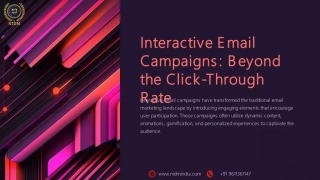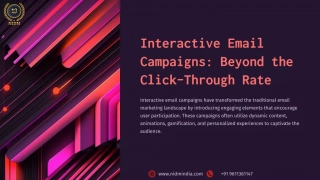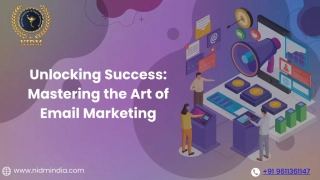
Digital Marketing Institute in Bangalore
NIDM (National Institute Of Digital Marketing) Bangalore Is One Of The Leading & best Digital Marketing Institute In Bangalore, India And We Have Brand Value For The Quality Of Education Which We Provide. Our Curriculum/ Courses Are Designed with Practical knowledge are Fully For Job Orientation Bases. We have the best curriculum, trainers and unlimited practical hours on live project.nn//nidmindia.com/
Uploaded on | 3 Views
Download Presentation

Please find below an Image/Link to download the presentation.
The content on the website is provided AS IS for your information and personal use only. It may not be sold, licensed, or shared on other websites without obtaining consent from the author. Download presentation by click this link. If you encounter any issues during the download, it is possible that the publisher has removed the file from their server.
E N D
Presentation Transcript
NATIONAL Institute OF DIGITAL MARKETING Email: nidmindia@gmail.com Bangalore BTM Layout
PERSONALIZED MARKETING
INDEX: 1.Introduction to Personalized Marketing Definition Benefits of Personalized Marketing The Importance of personalization of Todays Marketing Landscape 2. Understanding Your Target Audience Demographic segmentation Psychographic segmentation Behavioral segmentation 3. Data Collection and Management Types of Data for Personalization (First-Party, Second-Party, Third-Party) Data Collection Methods (Surveys, Website Analytics, CRM, Social Media) Data Management Platforms (DMPs) and Customer Data Platforms (CDPs) 4Personalization Technologies and Tools Marketing Automation Platforms) Personalization Engines and Recommendation Systems A/B Testing and Optimization Tools 5. Measuring and Optimizing Personalized Marketing Efforts Key Performance Indicators (KPIs) for Personalization Analytics and Reporting A/B Testing and Experimentation 6. Future of Personalized Marketing Emerging Trends and Technologies Privacy and Regulatory Considerations The Balance Between Personalization and Privacy
INTRODUCTION TO PERSONALIZED MARKETING Personalized marketing has emerged as a game-changer in the world of advertising and customer engagement. In an era where consumers are bombarded with countless marketing messages, personalization offers a powerful way to cut through the noise and deliver truly relevant and tailored experiences.
Definition of Personalized Marketing A marketing strategy that leverages customer data and insights to deliver tailored and individualized messaging, content, offers, and experiences to specific customers or audience segments. Benefits of Personalized Marketing 1.Increased Engagement and Conversion Rates Personalized messages and offers that are tailored to individual interests and preferences tend to resonate better with customers. This leads to higher engagement metrics like open rates, click-through rates, and ultimately, improved conversion rates for desired actions like sales or sign-ups. 2.Enhanced Customer Experience By providing relevant, timely, and contextual experiences, personalized marketing demonstrates to customers that a brand understands and values them as individuals. This personalized attention enhances the overall customer experience, driving greater satisfaction and loyalty.
3. Improved Customer Retention and Lifetime Value Customers who feel that a brand "gets them" and meets their specific needs are more likely to remain loyal and continue doing business with that brand over time. Personalization can significantly improve customer retention rates and increase customer lifetime value. 4.Better Targeting and Resource Optimization With personalized marketing, businesses can focus their marketing efforts and resources on the most relevant and valuable customer segments, rather than wasting budget on mass marketing tactics with lower ROI. 5.Competitive Differentiation As more businesses adopt personalization strategies, those that excel in delivering truly individualized experiences gain a competitive advantage by standing out in a crowded marketplace. 6.Increased Cross-Selling and Upselling Opportunities By understanding customer preferences and behaviors, businesses can identify and recommend complementary products or services that customers are more likely to purchase, driving additional revenue through cross-selling and upselling. 7.Valuable Customer Insights The data collected and analyzed for personalized marketing efforts provides businesses with valuable insights into their customers' needs, pain points, and decision-making processes, informing future product development and marketing strategies. The Importance of personalization of Todays Marketing Landscape Personalization has become increasingly important in today's marketing landscape for several reasons: 1.Rising Customer Expectations Consumers today expect a more personalized and tailored experience from brands. They are bombarded with countless marketing messages and have grown accustomed to companies understanding their individual needs and preferences. Personalization is no longer a luxury; it's a basic expectation. 2.Proliferation of Customer Data The rise of digital technologies and online interactions has led to an explosion of customer data. Businesses now have access to vast amounts of information about their customers' behaviors, interests, and purchase histories. This data provides the insights necessary to deliver relevant, personalized experiences. 3.Increased Competition and Differentiation In many industries, products and services have become commoditized, making it challenging for businesses to differentiate themselves solely based on their offerings. Personalization has emerged as a powerful way for brands
to stand out from competitors by providing unique, individualized experiences that foster stronger customer relationships. 4.Omni channel Customer Journeys Customers today interact with brands across multiple touch points , including websites, mobile apps, social media, and physical locations. Personalization allows businesses to create seamless, consistent experiences that cater to each customer's preferences and behaviors, regardless of the channel. 5.Improved Marketing Effectiveness Personalized marketing campaigns consistently outperform generic, one-size-fits-all approaches. By delivering relevant content and offers based on individual customer data, businesses can significantly improve metrics such as open rates, click-through rates, and conversion rates, driving better return on investment (ROI) for their marketing efforts. 6.Customer Loyalty and Retention Personalization plays a crucial role in fostering customer loyalty and retention. Customers are more likely to remain loyal to brands that demonstrate a deep understanding of their needs and preferences, consistently providing personalized experiences that add value. Understanding Your Target Audience
Understanding your target audience is a critical component of effective personalized marketing. 1. Demographics Collect and analyze demographic data such as age, gender, location, income level, education, and marital status. This information can help you segment your audience and tailor your messaging and offers accordingly. Psychographics Go beyond demographics by understanding your audience's values, interests, lifestyles, personalities, and behaviors. This psychographic data provides insights into their motivations, preferences, and decision-making processes. Purchase Behavior Analyze your customers' purchase histories, including products or services they've bought, frequency of purchases, average order values, and any seasonal or recurring patterns. This data can help you identify cross-selling and upselling opportunities, as well as predict future purchasing behavior. Online Behavior Track how your audience interacts with your website, mobile app, or other digital platforms. This includes data such as pages visited, content consumed, search queries, and engagement with specific features or functionalities. Social Media Interactions Monitor your audience's activity on social media platforms, including the content they engage with, the topics they discuss, and the influencers or brands they follow. This can provide valuable insights into their interests, opinions, and online behaviors. Feedback and Reviews Actively collect and analyze customer feedback, reviews, and testimonials. This qualitative data can offer deep insights into their pain points, preferences, and overall sentiment towards your brand or products. Customer Surveys and Interviews Conduct surveys, focus groups, or one-on-one interviews to gather direct feedback and insights from your target audience. This can help you uncover valuable information that may not be readily apparent through other data sources. 2. 3. 4. 5. 6. 7. By combining and analyzing these various data sources, you can create detailed personas or audience segments that represent your target customers. This understanding will inform your personalized marketing strategies, enabling you to deliver more relevant, compelling, and effective experiences tailored to your audience's unique needs and preferences. DEMOGRAPHIC SEGMENTION
Demographic segmentation is a crucial aspect of understanding and targeting specific groups within your overall audience for personalized marketing efforts. It involves dividing your customer base into distinct segments based on demographic characteristics such as: 1.Age Age is one of the most common demographic segmentation criteria. Different age groups often have varying interests, preferences, media consumption habits, and purchasing behaviors. For example, marketing strategies for Gen Z customers may differ significantly from those targeting Baby Boomers. 2.Gender Gender plays a significant role in shaping consumer attitudes, preferences, and buying decisions across various industries, from fashion and beauty to automotive and technology. 3.Income Level Income levels can influence purchasing power, product or service preferences, and responsiveness to pricing strategies. Businesses may tailor their messaging, offers, and distribution channels based on income segments. 4.Education Level Education level can affect factors like communication style, brand perceptions, and decision-making processes. Higher education levels may correlate with different interests or preferences compared to lower education levels.
5.Geographic Location Geographic segmentation involves dividing customers based on their physical location, such as country, state, city, or even neighborhood. This is particularly important for businesses with location-specific products, services, or marketing campaigns. 6.Family Status Marital status, presence of children, and family size can significantly impact consumer needs, priorities, and buying behaviors. For instance, marketing strategies for single individuals may differ from those targeting families with children. 7.Occupation Occupation can influence income levels, interests, and lifestyles, making it a relevant demographic factor for certain products or services. For example, marketing strategies for professionals may differ from those targeting blue-collar workers. Psychographic Segmentation
Psychographic segmentation is a powerful approach to understanding and targeting specific groups within your audience based on their psychological attributes, such as values, interests, lifestyles, personalities, and behaviors. Here are some key aspects of psychographic segmentation: 1.Values and Beliefs Segmenting customers based on their core values, beliefs, and ethical principles can provide valuable insights into their decision-making processes and brand affinities. For example, environmentally conscious individuals may gravitate towards eco- friendly or sustainable products. 2.Interests and Hobbies Identifying customers' interests, hobbies, and passions can help tailor marketing messages, product recommendations, and content strategies. For instance, outdoor enthusiasts may respond better to campaigns featuring outdoor activities or adventure themes.
3.Lifestyle Lifestyle segmentation considers factors such as activities, interests, opinions, and spending habits. This can include segmenting customers based on whether they are health- conscious, tech-savvy, fashion-forward, or prioritize work-life balance. 4.Personality Traits Understanding personality traits, such as introversion/extroversion, risk- taking propensity, or attention to detail, can inform communication styles, messaging tones, and product positioning. 5.Attitudes and Opinions Segmenting customers based on their attitudes towards specific brands, products, or social issues can help shape messaging and positioning strategies that resonate with their beliefs and mindsets. 6.Buying Behavior and Motivations Analyzing customers' buying behaviors, such as impulsive versus planned purchases, price sensitivity, or brand loyalty, can provide insights into their motivations and decision-making processes. It's important to note that psychographic segmentation often works best when combined with demographic and behavioral data, creating a comprehensive customer profile that informs personalized marketing efforts across various touch points and channels. Behavioral Segmentation Behavioral segmentation is a method of dividing your audience or customer base into groups based on their observed behaviors, actions, and interactions with your brand, products, or services.
This approach focuses on how customers behave, rather than solely on demographic or psychographic characteristics. Here are some key aspects of behavioral segmentation: 1.Purchase Behavior This includes factors such as purchase history, frequency of purchases, average order value, product or service preferences, and spending patterns. Customers can be segmented based on whether they are new or returning customers, their loyalty levels, or their propensity for cross-selling or upselling opportunities. 2.Channel Preferences Behavioral segmentation can involve analyzing customers' preferred channels for engaging with your brand, such as website, mobile app, physical store, or social media platforms. This information can help tailor your marketing and communication strategies for each channel. 3.Engagement Behavior This involves tracking how customers interact with your brand across various touchpoints, such as website visits, content consumption, email opens and clicks, social media interactions, or event attendance. Highly engaged customers can be targeted differently from those with lower engagement levels. 4.Usage Behavior For products or services with ongoing usage, customers can be segmented based on their usage patterns, frequency of use, or specific features they utilize. This data can inform product development, support, and retention strategies. 5.Response to Marketing Efforts Analyzing customers' responses to various marketing campaigns, promotions, or offers can help identify segments based on their receptiveness to different marketing tactics, messaging, or incentives. 6.Life-cycle Stage Customers can be segmented based on their current life-cycle stage with your brand, such as prospects, new customers, active customers, or churned customers. This information can guide appropriate marketing strategies for acquisition, retention, or win- back campaigns. Behavioral segmentation is often used in combination with demographic and psychographic segmentation to create comprehensive customer profiles and drive truly personalized marketing strategies across various channels and touch points. Data Collection and Management Data collection and management are critical components of effective personalized marketing strategies. Businesses need to gather, organize, and analyze customer data from various sources to gain insights and create tailored experiences
Data Sources Businesses can collect customer data from a variety of sources, including website interactions, mobile apps, customer relationship management (CRM) systems, social media platforms, surveys and feedback forms, transactional data, and third-party data providers. It's essential to identify and leverage relevant data sources that provide valuable insights into customer behaviors, preferences, and interactions. Data Collection Methods There are various methods for collecting customer data, such as cookies and web tracking, mobile app analytics, social media listening tools, email and marketing automation platforms, point-of-sale systems, and customer surveys or feedback forms. Businesses should implement appropriate data collection methods while adhering to privacy regulations and obtaining necessary customer consent. Data Integration and Management As customer data accumulates from multiple sources, it's crucial to have a centralized data management system that can integrate, organize, and structure this information. This may involve using a customer data platform (CDP), data warehouses, or customer relationship management (CRM) systems to consolidate and manage customer data effectively.
Data Quality and Governance Ensuring data quality is essential for accurate insights and effective personalization. This includes processes for data cleansing, deduplication, and standardization to maintain data integrity. Additionally, businesses should establish data governance policies and procedures to ensure compliance with privacy regulations, data security, and ethical data usage practices. Data Analysis and Segmentation Once customer data is collected and organized, businesses can analyze it using various techniques, such as data mining, predictive analytics, and machine learning algorithms. This analysis helps identify patterns, trends, and insights that can be used to create customer segments based on demographics, behaviors, preferences, or other relevant criteria. Data Privacy and Security As personalized marketing relies heavily on customer data, businesses must prioritize data privacy and security. This includes implementing robust data protection measures, obtaining customer consent for data usage, providing transparency about data collection and usage practices, and adhering to relevant data privacy regulations (e.g., GDPR, CCPA). Types of Data for Personalization (First-Party, Second-Party, Third-Party) When it comes to data for personalization, businesses can leverage three main types of data sources: first- party, second-party, and third-party data.
1.First-Party Data: First-party data is the information collected directly from your customers and their interactions with your brand, products, or services. This data is considered the most valuable and reliable for personalization efforts. Examples of first-party data include: Website and mobile app interactions (e.g., browsing behavior, purchases, content engagement) Customer relationship management (CRM) data (e.g., contact information, purchase history, service interactions) Email and marketing campaign data (e.g., open rates, click-through rates, preferences) Customer surveys and feedback Loyalty program data First-party data provides a direct and comprehensive view of your customers' behaviors, preferences, and interactions with your brand, enabling highly personalized experiences. 2.Second-Party Data: Second-party data is essentially someone else's first-party data that you have acquired through a direct partnership or data-sharing agreement. This type of data can complement your existing first-party data and provide additional insights into your target audience. Examples of second-party data sources include: Data partnerships with non-competing businesses that share similar customer bases Co-marketing or co-branding initiatives with partner companies Data exchanges or marketplaces where companies share their first-party data Second-party data can be valuable for expanding your understanding of your customers and reaching new audiences, but it requires careful vetting of data sources and adherence to privacy regulations. 3.Third-Party Data: Third-party data is information collected and aggregated by external data providers or companies that do not have a direct relationship with your customers. This data is typically derived from various online and offline sources and can provide broader insights into consumer behaviors, interests, and demographics. Examples of third-party data sources include: Data brokers and aggregators Market research companies Public databases and government sources Credit bureaus and financial institutions While third-party data can be useful for segmentation and audience targeting, it is often less reliable and accurate than first-party data, and its usage may raise privacy concerns.
Data Collection Methods (Surveys, Website Analytics, CRM, Social Media) here are various data collection methods that businesses can employ to gather customer insights for personalized marketing efforts. Here are some key methods and their descriptions: 1.Surveys: Surveys are a direct way to collect customer feedback and preferences. They can be distributed through email, websites, mobile apps, or even in-person at physical locations. Surveys can gather both quantitative data (e.g., multiple-choice questions, ratings) and qualitative data (e.g., open-ended questions, comments)./ 2.Website Analytics: Web analytics tools track and analyze visitor behavior on your website, providing valuable insights into how users interact with your online content and offerings. This data can include page views, clicks, time spent on pages, traffic sources, and conversion rates, among other metrics. 3.Customer Relationship Management (CRM) Systems: CRM systems store and organize customer data, including contact information, purchase history, communication records, and notes from interactions with sales or support teams. This data can provide a comprehensive view of individual customer journeys and preferences. 4.Social Media Analytics: Social media platforms offer analytics tools that can track user engagement, sentiment, and interactions with your brand's social media content and campaigns. This data can reveal valuable insights into your audience's interests, opinions, and online behaviors. 5.Mobile App Analytics: For businesses with mobile apps, analytics tools can track app usage, in-app purchases, feature interactions, and user behavior patterns. This data can inform personalized app experiences, content recommendations, and targeted push notifications. 6.Point-of-Sale (POS) Systems: POS systems capture transactional data, such as products purchased, purchase amounts, and payment methods. This data can reveal valuable insights into customer buying patterns, preferences, and opportunities for cross-selling or upselling. 7.Internet of Things (Iot) Data: As connected devices and sensors become more prevalent, businesses can collect data from Iot devices to understand customer usage patterns, preferences, and behaviors in real-world scenarios.
8.Third-Party Data Sources: Businesses can also leverage third-party data sources, such as data brokers, market research companies, or public databases, to supplement their own customer data with additional demographic, psychographic, or behavioral insights. Data Management Platforms (DMPs) and Customer Data Platforms (CDPs) Data Management Platforms (DMPs) and Customer Data Platforms (CDPs) are two important tools used in the management and utilization of customer data for personalized marketing efforts. Data Management Platforms (DMPs): A DMP is a centralized data platform that collects, integrates, and manages various types of audience data from multiple sources, both online and offline. The primary functions of a DMP include: 1.Data Collection: DMPs gather data from various sources, including website analytics, advertising platforms, third-party data providers, and customer relationship management (CRM) systems. 2.Data Integration: DMPs consolidate and organize data from disparate sources into a unified platform, enabling a comprehensive view of audience segments and behaviors.
3.Audience Segmentation: Using the collected data, DMPs allow marketers to create detailed audience segments based on demographics, behaviors, interests, and other criteria. 4.Data Activation: DMPs facilitate the distribution and activation of audience segments across various marketing channels, such as programmatic advertising, social media, and email campaigns. DMPs are particularly useful for brands and agencies that rely heavily on programmatic advertising and audience targeting for their marketing efforts. Customer Data Platforms (CDPs): A CDP is a unified platform that collects, integrates, and manages first-party customer data from various sources, with the primary goal of creating comprehensive, persistent customer profiles. The key functions of a CDP include: 1.Data Collection: CDPs ingest first-party data from sources like CRM systems, website interactions, mobile apps, point-of-sale systems, and other customer touch points. 2.Data Unification: CDPs consolidate and unify customer data from multiple sources, creating a single customer view or "golden record" for each individual. 3.Customer Profiles: CDPs create detailed, persistent customer profiles that capture various attributes, behaviors, preferences, and interactions over time. 4.Data Activation: CDPs enable the distribution and activation of customer data and insights across various marketing channels, such as email, mobile apps, web personalization, and customer service interactions. CDPs are particularly valuable for businesses that prioritize customer-centric strategies, personalized experiences, and omni channel marketing efforts. While DMPs and CDPs share some similarities in data management and audience targeting capabilities, CDPs focus specifically on first-party customer data and creating comprehensive customer profiles, while DMPs often incorporate third-party data sources for audience segmentation and programmatic advertising. Many businesses use a combination of DMPs and CDPs, leveraging the strengths of each platform to enhance their personalized marketing strategies and deliver more relevant, contextualized experiences across multiple touch points.
Personalization Technologies and Tools Personalized marketing relies on various technologies and tools to collect, analyze, and leverage customer data effectively. Here are some key technologies and tools used for personalization: 1.Customer Data Platforms (CDPs) As mentioned earlier, CDPs are central platforms that consolidate and unify customer data from multiple sources to create comprehensive customer profiles. These platforms enable segmentation, analysis, and activation of customer data for personalized marketing campaigns across channels. 2.Web Personalization Engines Web personalization engines use collected customer data to dynamically adjust website content, offers, and experiences based on individual visitor preferences and behaviors. Examples include Optimizely, Adobe Target, and Evergage. Recommendation Engines Recommendation engines analyze customer data, such as browsing history, purchase patterns, and preferences, to provide personalized product or content recommendations. Examples include Amazon's recommendation system, Netflix's recommendation engine, and Spotify's Discover Weekly playlists. 3.Marketing Automation Platforms Marketing automation platforms like HubSpot, Marketo, and Pardot enable businesses to create personalized marketing campaigns, nurture customer journeys, and automate communication based on customer behaviors and
triggers. 4.Predictive Analytics and Machine Learning Predictive analytics and machine learning algorithms analyze customer data to identify patterns, make predictions about future behaviors, and optimize personalization strategies. These techniques are used in various personalization tools and platforms. 5.A/B Testing and Experimentation Tools A/B testing and experimentation tools, such as Optimizely and Google Optimize, enable businesses to test different variations of personalized experiences (e.g., landing pages, emails, product recommendations) and analyze their performance to optimize for better results. 6.Customer Relationship Management (CRM) Systems CRM systems like Salesforce, Microsoft Dynamics, and HubSpot CRM store and manage customer data, interactions, and relationships, providing a valuable source of information for personalized marketing efforts. 7.Analytics and Business Intelligence (BI) Tools Analytics and BI tools like Google Analytics, Adobe Analytics, and Tableau help businesses analyze customer data, create visualizations, and derive insights that inform personalization strategies. 8.Content Management Systems (CMS) Modern CMS platforms, such as Adobe Experience Manager, Sitecore, and Contentful, offer personalization capabilities that allow businesses to deliver personalized content experiences based on customer data and preferences. Marketing Automation Platforms Marketing automation platforms are software tools designed to streamline and automate various marketing processes, including personalized marketing efforts. These platforms play a crucial role in delivering tailored and timely communications to customers and prospects based on their behaviors, preferences, and interactions with the brand.
Popular examples of marketing automation platforms include HubSpot, Marketo, Pardot (by Salesforce), Oracle Eloqua, and Adobe Marketo Engage. By leveraging these platforms, businesses can efficiently execute personalized marketing campaigns at scale, deliver relevant and timely communications, and ultimately enhance customer engagement and conversions. Personalization Engines and Recommendation Systems Personalization engines and recommendation systems are pivotal components of modern digital platforms, shaping user experiences across a variety of domains, from e-commerce to entertainment and beyond.
A/B Testing and Optimization Tools A/B testing and optimization tools are fundamental components of the iterative improvement process in various domains, including marketing, product development, and user experience design. These tools enable organizations to experiment with different variations of content, features, or designs and measure their impact on key performance metrics. A/B Testing: A/B Testing: A/B testing, also known as split testing, involves comparing two or more versions of a webpage, app feature, email campaign, or other elements to determine which one performs better in terms of predefined metrics. Process: Process: 1.Hypothesis: Hypothesis: Formulate a hypothesis about a change that could improve a specific metric (e.g., conversion rate, click-through rate). 2.Variations: Variations: Create multiple versions (variants) of the element being tested, with one serving as the control (existing version) and the others as variations with the proposed change(s). 3. 4.Randomization: Randomization: Randomly assign users or visitors to different variations to ensure unbiased results. 5.Measurement: Measurement: Collect data on relevant metrics for each variation. 6.Analysis: Analyze the data to determine which variation performed better according to the defined success metric(s). 7.Implementation: Implementation: Implement the winning variation to realize improvements in perfor
Opt Optimization Tools: imization Tools: Optimization tools are software platforms or frameworks designed to facilitate A/B testing and other optimization techniques, providing features such as experiment management, data analysis, and reporting. Features: Features: oExperiment Setup: Tools offer user-friendly interfaces for creating and configuring A/B tests, including defining variations, setting goals, and specifying targeting criteria. oTraffic Allocation: Automated traffic allocation features ensure that users are evenly distributed across different variations, preventing bias in test results. oStatistical Analysis: Built-in statistical analysis capabilities help interpret test results, including confidence intervals, p-values, and statistical significance. oIntegration: Integration with other analytics tools and platforms allows seamless data exchange and deeper insights into user behavior. oPersonalization: Some advanced optimization tools support personalized experiences by dynamically serving content based on user attributes or behavior. Measuring and Optimizing Personalized Marketing Efforts Measuring and optimizing personalized marketing efforts involves a combination of data analysis, experimentation, and continuous refinement to ensure that marketing strategies effectively engage target audiences and drive desired outcomes. Here's a comprehensive approach to measuring and optimizing personalized marketing efforts: Define Key Performance Indicators (KPIs): Define Key Performance Indicators (KPIs): Identify specific metrics that align with your marketing objectives and reflect the effectiveness of personalized campaigns. Examples include conversion rate, customer lifetime value, engagement metrics (e.g., click-through rate, time spent on site), and ROI. Data Collection and Analysis: Data Collection and Analysis:
Gather relevant data from various sources, including customer interactions, website analytics, CRM systems, and marketing automation platforms. Utilize advanced analytics techniques, such as segmentation, cohort analysis, and predictive modeling, to gain insights into customer behavior, preferences, and trends. A/B Testing and Experimentation: A/B Testing and Experimentation: Conduct A/B tests to evaluate the effectiveness of different personalization strategies, such as tailored content, offers, or messaging. Test variations of personalized campaigns, including different audience segments, creative elements, messaging tones, and delivery channels. Personalization Algorithms and Machine Learning: Personalization Algorithms and Machine Learning: Leverage personalization engines and machine learning algorithms to dynamically adjust marketing content and recommendations based on individual user attributes, behaviors, and preferences. Continuously train and refine personalization models using feedback data to improve prediction accuracy and relevance over time Customer Feedback and Satisfaction: Customer Feedback and Satisfaction: Collect feedback from customers through surveys, reviews, and social media channels to gauge satisfaction with personalized experiences. Use qualitative insights to understand customer preferences, pain points, and areas for improvement in personalized marketing efforts. Cross Cross- -Cha Channel Integration: nnel Integration: Integrate personalized marketing efforts across multiple channels, including email, social media, website, mobile apps, and offline channels (e.g., in-store experiences). Ensure consistency and coherence in messaging and branding across different touch points to provide a seamless and cohesive customer experience. Continuous Optimization: Continuous Optimization:
Iterate and refine personalized marketing strategies based on insights gained from data analysis, experimentation, and customer feedback. Adopt a test-and-learn approach to continuously optimize campaigns, messaging, and targeting strategies to maximize ROI and customer engagement. Compliance and Privacy: Compliance and Privacy: Ensure compliance with data protection regulations (e.g., GDPR, CCPA) and adhere to ethical guidelines for data usage and personalization practices. Respect customer privacy preferences and provide transparency regarding data collection, usage, and personalization efforts. Key Performance Indicators (KPIs) for Personalization Key Performance Indicators (KPIs) for personalization measure the effectiveness of personalized experiences in achieving specific business goals and objectives. Here are some essential KPIs to consider when evaluating the performance of personalization efforts: 1.Conversion Conversion Rate: action, such as making a purchase, signing up for a newsletter, or completing a form. Personalized experiences should aim to increase conversion rates by delivering relevant content or recommendations tailored to individual preferences. 2.Average Order Value (AOV): Average Order Value (AOV): Track the average monetary value of orders placed by customers. Personalization strategies that encourage upselling or cross-selling relevant products or services can lead to an increase in AOV, indicating higher customer Rate: Measure the percentage of website visitors or users who take a desired
engagement and satisfaction. 3.Customer Lifetime Value (CLV): Customer Lifetime Value (CLV): Evaluate the long-term value that personalized experiences generate from individual customers over their entire relationship with the business. Higher CLV indicates that personalized marketing efforts are successful in fostering loyalty, repeat purchases, and customer retention. 4.Click Click- -Through Rate (CTR): Through Rate (CTR): Measure the percentage of users who click on a specific link, advertisement, or call-to-action (CTA) within a personalized experience. A higher CTR suggests that personalized content or recommendations resonate with users and drive engagement. 5.Bounce Rate: Bounce Rate: Monitor the percentage of visitors who navigate away from a website after viewing only one page. Lower bounce rates indicate that personalized experiences effectively capture users' interest and encourage further exploration of the site or app. Analytics and Reporting Analytics and reporting in personalized marketing entail the comprehensive gathering, integration, and analysis of data from various sources to evaluate the effectiveness of tailored experiences. Through segmentation, cohort analysis, and predictive modeling, businesses derive actionable insights into user behavior and preferences, enabling the measurement of key performance indicators (KPIs) such as conversion rate, average order value (AOV), and customer lifetime value (CLV). Experimentation via A/B testing allows for the comparison of different personalization strategies and variations, with results informing continuous optimization efforts. Visualizations and dashboards communicate insights clearly, facilitating data-driven decision-making, while adherence to data privacy regulations ensures ethical handling of customer information. Overall, analytics and reporting empower organizations to refine personalized marketing strategies, maximize engagement, and drive meaningful outcomes.
A/B Testing and Experimentation A/B testing and experimentation are integral components of personalized marketing strategies, facilitating the iterative refinement of tailored experiences to maximize effectiveness. By systematically comparing different variations of content, messaging, and targeting criteria, businesses gain insights into which personalized strategies resonate most with their audience. Through randomized experiments and rigorous analysis of key metrics such as conversion rates, click-through rates, and customer engagement, organizations can identify winning variations and optimize their personalized marketing efforts to drive higher levels of customer satisfaction, retention, and ROI. This iterative approach to testing and experimentation empowers businesses to continuously refine their personalization strategies, adapt to evolving customer preferences, and achieve meaningful results in their marketing campaigns. Future of personalized marketing The future of personalized marketing holds tremendous promise, driven by advancements in technology, data analytics, and consumer expectations. Here are several key trends shaping the future of personalized marketing:
1.Artificial Intelligence and Machine Learning Artificial Intelligence and Machine Learning: AI and machine learning algorithms will play an increasingly vital role in delivering hyper-personalized experiences by analyzing vast amounts of data to understand individual preferences and behavior patterns. These technologies will power sophisticated recommendation engines, predictive analytics, and dynamic content generation, enabling brands to anticipate customer needs and deliver relevant messages at the right time and on the right channel. 2.Omni Omni- -Channel Personalization: Channel Personalization: With consumers interacting across multiple touch points and devices, the future of personalized marketing lies in seamlessly integrating data and experiences across channels. Brands will leverage omnichannel strategies to provide consistent, personalized interactions across websites, mobile apps, social media, email, and physical stores, creating cohesive customer journeys that drive engagement and loyalty. 3.Real Real- -Time Personalization: Time Personalization: Real-time data processing and automation will enable brands to deliver personalized experiences in the moment, responding to customer interactions and behaviors in real-time. Dynamic content optimization, triggered messaging, and adaptive website experiences will become standard practices, allowing brands to engage customers with relevant content and offers at every stage of their journey. 4.Privacy and Ethical Data Use: Privacy and Ethical Data Use: As consumer concerns about data privacy and security continue to grow, the future of personalized marketing will prioritize transparency, consent, and ethical data use. Brands will need to earn and maintain consumer trust by providing clear explanations of how data is collected, stored, and used for personalization purposes, while adhering to regulatory requirements and industry best practices. 5.Hyper Hyper- -Personalization at Scale: Personalization at Scale: Advancements in data analytics and automation will enable brands to achieve hyper-personalization at scale, tailoring marketing messages and offers to individual preferences and interests. From personalized product recommendations to customized pricing and promotions, brands will leverage data-driven insights to create highly targeted experiences that resonate with each customer on a one-to-one level. 6.User User- -Generated Personalization: Generated Personalization: Consumers increasingly expect brands to involve them in the personalization process, allowing them to customize their experiences based on their own preferences and feedback. User-generated content, co-creation initiatives, and interactive personalization tools will empower customers to shape their own journeys, fostering deeper engagement and brand loyalty. 7.Augmented Reality (AR) and Virtual Reality (VR): Augmented Reality (AR) and Virtual Reality (VR): AR and VR technologies will revolutionize personalized marketing by enabling immersive and interactive experiences that blur the lines between the physical and digital worlds. Brands will leverage AR and VR
to create personalized product demos, virtual try-on experiences, and interactive storytelling campaigns that captivate audiences anddrive conversions. Emerging Trends and Technologies Emerging trends and technologies are reshaping the landscape of personalized marketing, offering new avenues for brands to connect with consumers on a deeper level. From predictive analytics that anticipate customer needs to voice search and AI assistants that enable conversational interactions, the future of personalized marketing is characterized by hyper-automation and enhanced customer experiences. Augmented reality (AR) and virtual reality (VR) technologies are revolutionizing how brands engage with audiences, providing immersive and interactive experiences that drive engagement and conversion. Blockchain technology is improving data security and transparency, while customer data platforms (CDPs) are centralizing customer data to enable more accurate and comprehensive personalization. Contextual marketing, powered by real-time data and location-based information, delivers personalized messages tailored to the user's current context and intent. These emerging trends and technologies represent exciting opportunities for brands
to deliver more relevant, timely, and engaging experiences that resonate with consumers in today's dynamic digital landscape. Privacy and Regulatory Considerations Privacy and regulatory considerations are paramount in the realm of personalized marketing, especially in light of increasing concerns about data privacy and security. As brands collect and utilize vast amounts of consumer data to personalize experiences, they must adhere to stringent privacy regulations such as GDPR, CCPA, and other regional laws. Compliance with these regulations requires transparent data collection practices, explicit consent from users for data usage, and clear communication about how personal information is stored and processed. Brands must also prioritize data security measures to safeguard sensitive customer data from breaches or unauthorized access. Moreover, ethical considerations surrounding data usage and transparency are essential for maintaining consumer trust and loyalty. By prioritizing privacy and regulatory compliance, brands can build stronger relationships with customers, foster trust, and mitigate the risks associated with data misuse or mishandling.
The Balance Between Personalization and Privacy The balance between personalization and privacy is a delicate one in the realm of marketing. On one hand, personalization allows brands to deliver tailored experiences that resonate with individual preferences, driving engagement and loyalty. However, this customization relies on the collection and analysis of vast amounts of consumer data, raising concerns about privacy and data security. Achieving the right balance requires a nuanced approach that prioritizes both personalization and privacy. Brands must implement transparent data collection practices, obtain explicit consent from users for data usage, and provide clear explanations of how personal information will be used. Additionally, they should prioritize data security measures to protect sensitive customer data from breaches or misuse. By respecting consumer privacy preferences and maintaining ethical data practices, brands can build trust with customers and deliver personalized experiences that enhance engagement while safeguarding privacy rights. Striking this balance is essential for maintaining a positive brand reputation and fostering long-term customer relationships in today's digital landscape. Conclusion Personalized marketing goes beyond simple demographic segmentation and empowers organizations to truly understand their customers' unique preferences, behaviors, and interests. By leveraging various data sources, advanced analytics, and powerful personalization technologies, businesses can create highly personalized and compelling customer journeys that resonate with individual users.
Thank you






















